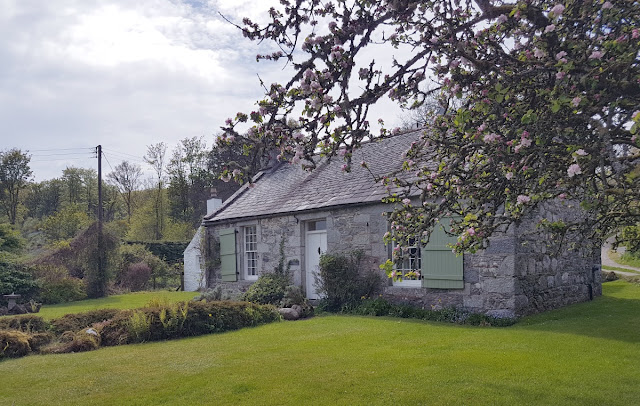The Tale of McCulloch of Myrton
We all love a good legend and around the Machars there's quite a few that I've come across so far and will share. But there seems to be something in the water particular to the parish of Mochrum.
To follow the White Loch of Myrton, the bells of Kirkmaiden church, St Medan herself, oh and a well..
Myrton Castle is not open to the public.
Myrton Castle overlooking The White Loch is a ruined tower, probably previously built over a 12c motte replacing a wooden constructed building. Abandoned in 1790, it was a fair complex and having a chapel, outbuildings etc. It had been the baronial home of the McCulloch's. The last McCulloch to occupy Myrton Castle was Sir Godfrey McCulloch who met his end in 1697 at Edinburgh's Grassmarket.
Sir Godfrey McCulloch was also one of the judges who condemned the Whithorn Matyrs.
The estate though had been mismanaged prior to Sir Godfrey and was in debt. Cardoness Castle had changed hands to the Gordons many years earlier and there was a fued between the two families. On the 2nd October 1690 McCulloch went to Gordons house with the intent of shooting him. McCulloch shot him in the leg and a few hours later Gordon died and on hearing the news McCulloch fled abroad.
or version two
Sir Godfrey McCulloch having squandered his patrimony and sold his estates in Mochrum to the Maxwells of Monreith, took up house at Cardoness. Here a neighbour, William Gordon, having poinded some cattle straying on his lands, Sir Godfrey joined a party illegally convened to release them. A fray was the result, in which McCulloch, in the words of his indictment, "did shoot at the said Gordon with a gun charged, and by the shot broke his thigh bone and leg, so that he immediately fell to the ground and within a few hours thereafter died of the same shot wound." Sir Godfrey fled the country.
anyway it's agreed that
Six years later McCulloch returned to Scotland and ventured on a Sunday to attend a church in Edinburgh. A Galloway man was among the congregation, who, recognising him, jumped up and cried: "Pit to the door, there's a murderer in the kirk!" This was done, McCullough arrested, tried, condemned, and his head "stricken fra his body" the 5th of March 1697. So say the Criminal Records:
Before his excution he sold his Barony to Sir William Maxwell of Monreith, Apparently he was the last criminal to be beheaded by 'The Maiden' located at the museum of Scotland, not according to Wiki, but then in this story, who knows...
Stranger still and like I say, it's in the water..
Long long before the fatal encounter, and before he had entered on the evil courses which led to his ruin, Sir Godfrey, young and curly, sat at a window in the Tower of Myrtoun watching the operations of a gang of workmen forming a new sewer from his house to the White Loch below it. Suddenly he was startled by the apparition close beside him of a very little old man whose hair and beard were snowy white, whose strangely-cut costume was green, and who seemed in a state of furious wrath.
Sir Godfrey received him, notwithstanding, with the greatest urbanity, and begged to be told in what way he could serve him. the answer was a startling one; "McCulloch," said the visitor, "I am the king of the brownies! My palace has been for ages in the mound on which your tower stands, and you are driving your common sewer right through my chalmer of dais [i.e. his best room]."
Sir Godfrey, confounded, threw up the window and ordered the workmen to stop at once, professing his perfect readisness to make the drain in any such direction as might least incommode his majesty, if he would graciously indicate the same. His courtesy was accepted, and Sir Godfrey received a promise in return from the now mollified potentate, that he, the said king, would stand by and help him in the time of his greatest need.
It was long after this that the knight of Myrtoun disposed of his enemy in the summary way we have already mentioned, and for which he was condemned to die. The procession had started for the place of excution; a crowd was collected to see the awful sight; when the spectators were surprised by seeing a very little man with white hair and beard, dressed too in an antique suit of green, and mounted on a white horse. He issued from the castle-rock, crossed the loch without a moment's hesitation, and rode straight up to the cart on which Sir Godfrey, accompanied by the executioner and a minister, was standing. They plainly saw Sir Godfrey get on the horse behind the little man, who was no other than the king of the brownies (and thus fulfilled his promise by arriving in his hour of need): the two recrossed the loch, and mounting the castle-rock they disappeared.
When the astonished crowd again turned their eyes to the cart a figure was still there, and wondrous like Sir Godfrey; it was, therefore, generally believed that he had met a felon's doom, and most people thought no more about it. A few only knew better, but these cared little to speak about the matter. At rare intervals, however, one of the initiated would impart the story to a friend, and tell how a head had rolled upon the ground, leaving a bleeding trunk upon the scaffold: then adding in a confidential whisper, "It was no' him ava, it was just a kin' o' glamour."
From Andrew Agnew's 'Hereditary Sheriffs of Galloway', volume 2, 1893.
J Maxwell 1911 Witchcraft and . . superstitious record in the south-western district of Scotland here
https://archive.org/details/witchcraftsupers00woodiala/page/168
About the McCulloch's and the Myrton Castle here



Comments
Post a Comment